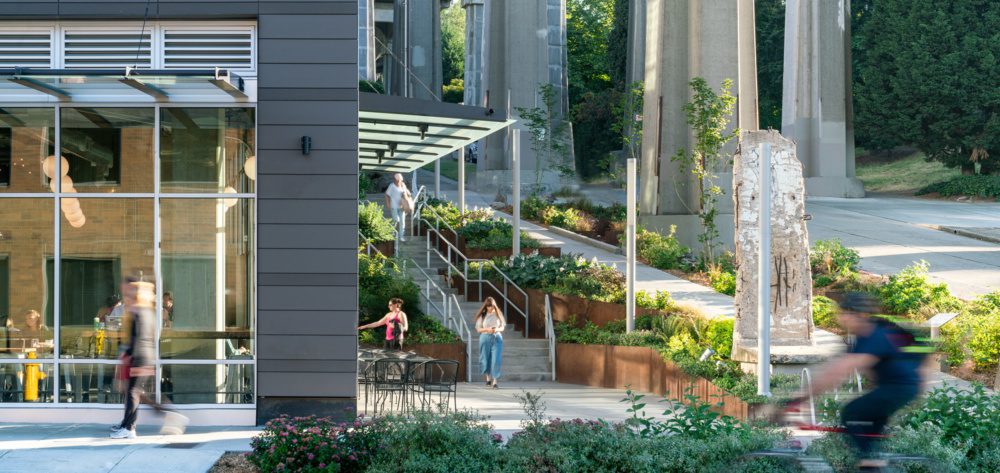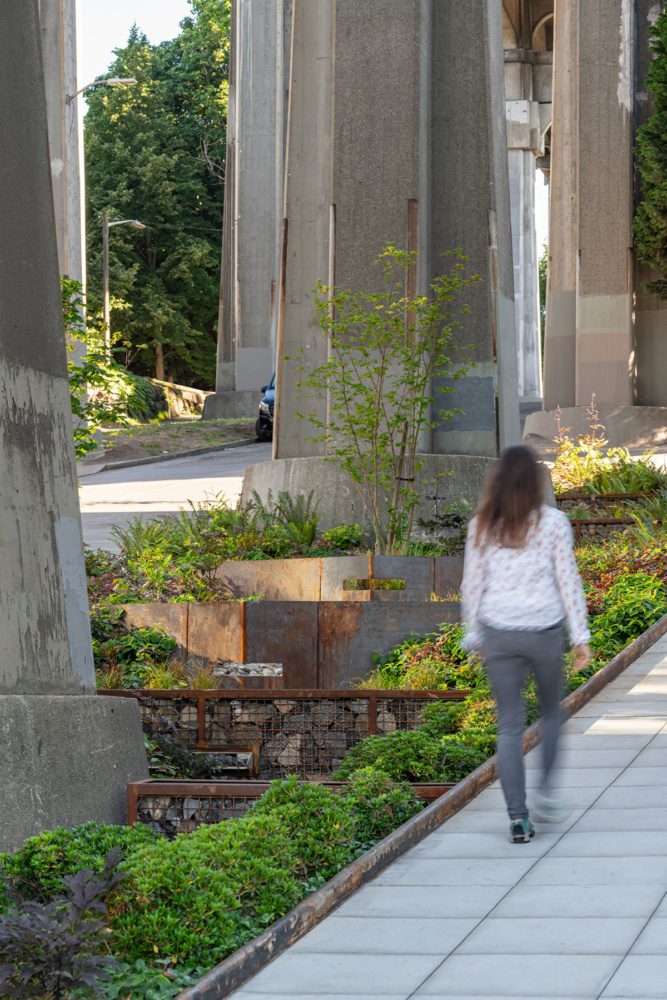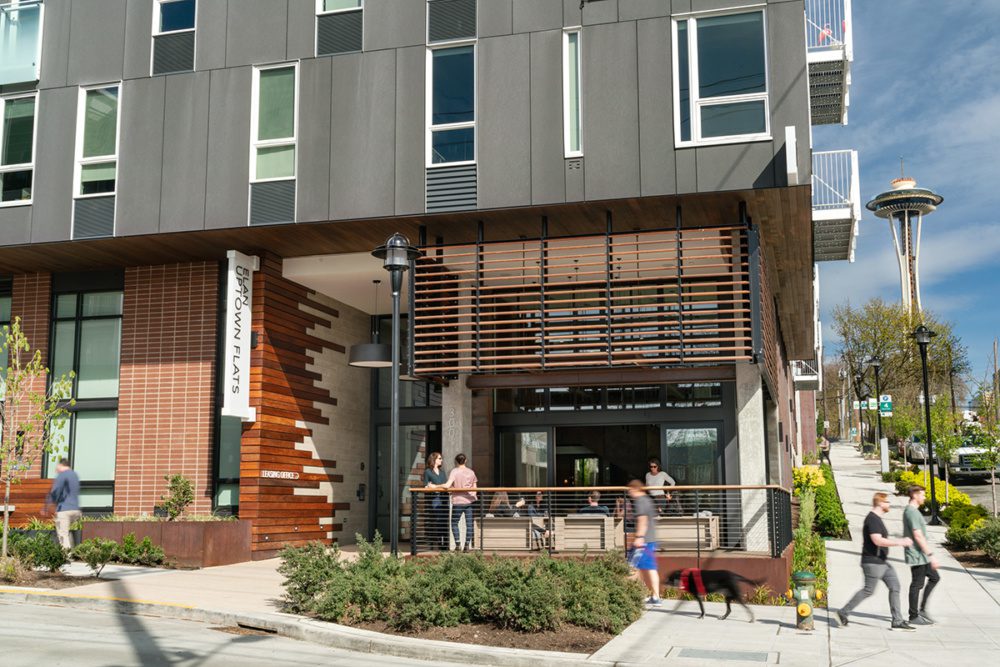By Shoshanah Haberman
Shoshanah joined Weber Thompson with a background in single-family residential design, giving her a deep appreciation of the Pacific Northwest plant palette and outdoor spaces that feel like home. At Weber Thompson, she has expanded her experience to include many different scales of design and enjoys problem-solving her way through challenging and complicated urban designs.
Providing character and softening the lines of the built environment, planting beds between our urban buildings play a vital role in urban landscapes. Street trees shade hot summer sidewalks, while shrubs and perennials provide a vibrant understory that ushers in birds and insects. A well-placed bench can provide a respite from the rush of city streets.
However, these landscapes can also be challenging to maintain.
Road salt and pollution, pedestrian traffic, dog urine, and trash can wear down plantings and leave behind barren expanses of dirt and dust. Spring maintenance, when done right, can alleviate these stresses and create a resilient plant community that will thrive in the growing season to come.

The landscape at DATA 1 offers a respite from the bustling urban environment.
Start from the ground level: Your soil is precious
Your soil is essential to the health of your plants. Don’t blow it away!
Blowers may be convenient for getting rid of trash and old leaves quickly, but they also blow away mulch, nutrients, and topsoil. Blasting trash and leaves into the air is also detrimental to air quality. Where possible, remove trash by hand or with a rake, and leave organic material that has accumulated in the planting beds to decompose in place. Rake leaves that have scattered over the sidewalk into the planting beds to do the same. Your plants will thank you for it!
Early in the season, hand pull weeds instead of using chemical weed killers when the roots are small and easy to remove. Repeat every few months.
Mulch to prevent weeds
The best way to prevent weeds is to add a thick layer (at least 3” thick) of mulch or compost on top of the soil. The organic material in your mulch will fuel the spring growth spurt and set your plants up for summer. For a quick boost, use a top dressing of compost. For long term gains, the best top dressing is arborist mulch, which will decompose slowly over the course of the year suppressing weeds and preventing erosion. Arborist mulch is also the most effective, cheapest, and sustainable form of mulch for most landscape situations.
If there is groundcover in planting beds, make sure not to bury it in mulch. Mulch blowers are good for a new planting bed before plants are installed, but after the plants are in place, it’s best to apply mulch by hand to avoid burying existing plants.
Take stock of what is growing in your planting beds
Spring is a great time to note gaps in the landscape and replace plants that are no longer viable. Stretches of bare dirt in your streetscape tend to spread as pedestrians use them as pathways, trampling the landscape. Filling these gaps improves the site aesthetic and reduces soil erosion. It also sends a message that this landscape is being cared for and should be treated respectfully.
Spring is a highly forgiving time for new plants, which respond to ideal growing temperatures and seasonal moisture by growing new roots, buds, blooms, and branches. Plant well before the heat and droughts of summer.
Protect your plants
Metal edging at the edge of sidewalk will go a long way in reminding pedestrians that the planting bed is not an extension of the sidewalk. Place a bench or a log between plantings and the sidewalk to add a lovely place to sit, and to create a barrier between plants and trampling feet.
Dog urine is very damaging to plants – add signs reminding people to take their dogs elsewhere to relieve themselves.

Metal edging along the Aurora Bridge Swales protects the plants from pedestrian traffic.
Pruning tips
Resist the urge to tidy up plants with a hedge trimmer. For most plants, shearing disrupts their natural form and growth potential. A hedge trimmer can also be a source of disease and indiscriminate cuts can hinder blooming. Reserve hedge trimmers for designs that call for clipped hedges and avoid trimming plants into neat little balls – it’s unattractive. Certain plants such as Lavender, Hebes, and Rock Roses require regular trimming. Prune these plants early in spring to encourage a healthy and consistent pattern of growth.
Trees, however, should never be sheared or topped.
Shearing isn’t an effective tool to control plant size. A sheared plant usually grows right back to its original size in a few months, but it will have lost its natural elegance.
If a plant has outgrown its allotted space, consider replacing it with a smaller plant, or moving it to a larger space. If you decide to keep the plant in its current location, turn to Cass Turnball’s Guide to Pruning. This guide has specific instructions for pruning each individual plant in the most effective and attractive way possible.
Don’t forget about your irrigation
Run your system well before the summer. Make sure there are no leaks, and that water pressure is consistent throughout your system. Check nozzles and sprinkler heads and make sure you are fully prepared for a hot, dry summer. Keep in mind, for the first two or three years of a plant’s life, even the most drought tolerant plants need supplemental summer water to survive.
Look around and enjoy the beauty!
Spring is a time of tremendous beauty in the Pacific Northwest, and your streetscape presents an opportunity to add vibrancy and joy to our urban environment. Thoughtful and consistent seasonal maintenance is the key to helping these streetscapes reach their full potential and to avoid the need for costly overhauls.

The landscape at Uptown Flats in Queen Anne reinforces community building and actively and passively engages the public realm at the street corner.
As the landscape matures, it becomes more self-sustaining, with roots that grow deeper, trees that provide larger, filtered shade, and groundcover that minimizes erosion and stifles weeds. A thriving urban tapestry of light, texture, and color emerges, providing a much-needed respite from the rigors of city life. A well-maintained streetscape transforms the rough edges of urban life into a cherished urban oasis that we can all enjoy.
